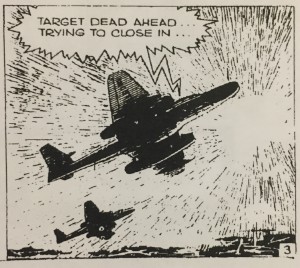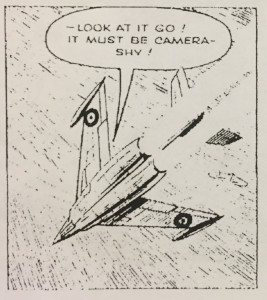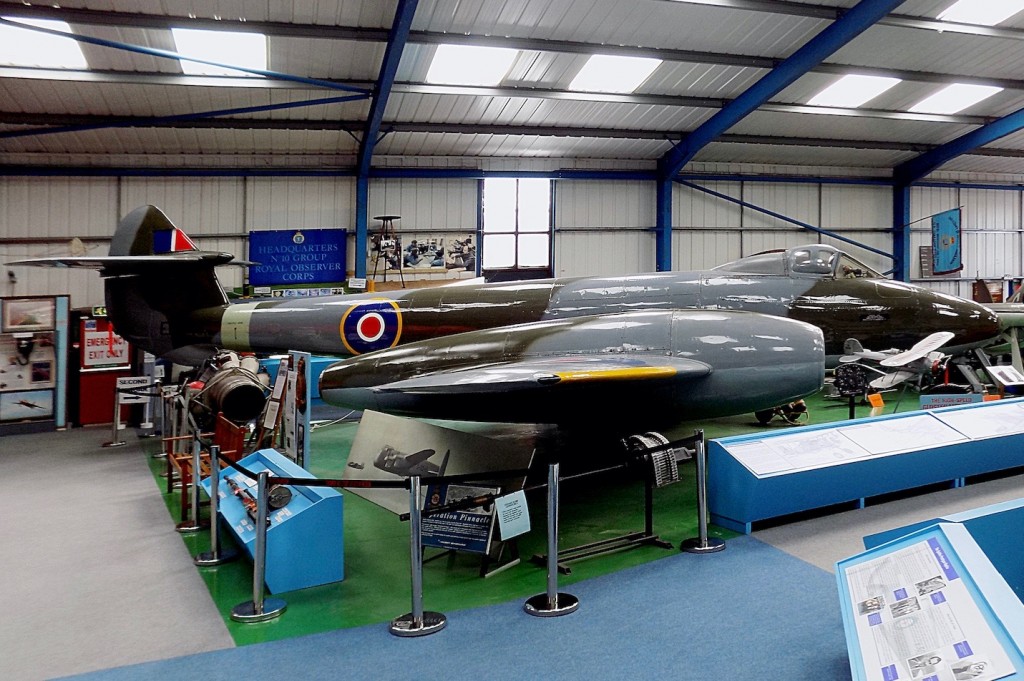30 Oct 16
![]() One of the aircraft on show at Tangmere air museum , which club members visited last September, was the Gloster Meteor, famous as Britain’s first jet fighter, which made its maiden flight in 1943 and which was used in combat from the summer of 1944 onwards. The Gloster Meteor is of special significance to the Jeff Hawke story as it was the first aircraft to appear in the strip at the start of the very first story – SPACERIDER. In strip no. 3 we see Meteors taking off to intercept the UFO
One of the aircraft on show at Tangmere air museum , which club members visited last September, was the Gloster Meteor, famous as Britain’s first jet fighter, which made its maiden flight in 1943 and which was used in combat from the summer of 1944 onwards. The Gloster Meteor is of special significance to the Jeff Hawke story as it was the first aircraft to appear in the strip at the start of the very first story – SPACERIDER. In strip no. 3 we see Meteors taking off to intercept the UFO

which has been picked up on RAF radar. In reality the Meteor set the first official air speed record at the end of 1945 achieving a speed of 606 mph, but despite this , the squadron sent to investigate the UFO , although able to make visual contact, could not maintain the pursuit. Only the XP5 , a fictitious aircraft invented by Sydney for the strip which he describes as “ an extrapolation of the jet fighters of the Day” was capable of matching speed with the alien craft. Fortunately a certain squadron leader Hawke was on hand to take her up in pursuit – and the rest is history. Skipper Prossitt


There was a not dissimilar episode with a Gloster Meteor and UFOs in October 1952, on a training flight over Gloucestershire. At 14,000 feet the instructor, Michael Swiney (later an Air Commodore), drew the attention of the trainee, David Crofts (later a Lieutenant-Commander RN), to three silvery discs ahead of them. Although they had a lens-shape, so that their appearance altered with changes in perspective, they were otherwise featureless, with no detail like the windowed flight deck, tail-fins and jets of the Shining Ones’ saucer. The sighting was apparently confirmed by radar, but as with so many UFO encounters – unlike Hawke’s – nothing of consequence ensued. (‘Timewatch: Britain’s UFO Files’, BBC-2, 8th January 2005.) In the second edition of his autobiography “Wings on my Sleeve” (Weidenfeld & Nicolson, 2006), the late Capt. Eric ‘Winkle’ Brown describes being sent up in a Vampire in February 1956 to try to intercept one over the Bristol Channel, but it was too high for him, well over 40,000 feet. In his interview at the launch of my book “The Elements of Time” in September this year, Sydney Jordan said the events at the beginning of Jeff Hawke were inspired by the death of Capt. Thomas Mantell, who died in January 1948 while chasing a UFO ‘metallic and tremendous in size’ in an F-51. The most likely explanation is that Mantell was actually chasing a Mogul spy balloon (still classified at the time) and passed out due to lack of oxygen, possibly realising his danger and throwing his aircraft into a dive from which he failed to recover in time.